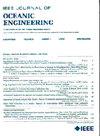基于信道增强、高效和有效的水下显著目标检测网络
IF 5.3
2区 工程技术
Q1 ENGINEERING, CIVIL
引用次数: 0
摘要
水下显著目标检测(USOD)旨在识别水下环境中最关键的元素,在水下勘探中具有重要的潜力。现有的方法往往忽略了光退化或涉及更大的网络规模,这些都不适合水下移动平台,并且给实践带来了挑战。鉴于低复杂度算法在水下应用中优化系统效率的重要性,本文介绍了CE$^{3}$ usod——一种高效的网络,旨在为水下场景中的显著目标检测提供有效的解决方案。一方面,我们从邻域的角度重新考虑远程依赖关系和特征计算,从而开发出远程上下文感知模块。具体来说,我们通过结合不同窗口大小内相邻像素的最大值和平均值来近似局部和全局上下文感知,这使得我们的方法在保持低计算成本的同时实现高性能。另一方面,在水下成像过程中,光的散射和吸收往往导致捕获的水下图像通道强度不平衡。为了解决这一问题,我们提出了颜色引导金字塔聚合模块,该模块利用水下图像增强技术增强的较弱颜色通道作为多尺度特征融合的引导,最终促进模型获得水下域信息。在四个公共基准测试上进行的大量实验表明,我们的创新网络在保持低模型尺寸(参数为0.546M)和计算复杂度(FLOPs为0.416G)的同时取得了最先进的结果。因此,CE$^{3}$ USOD被证明是有效和高效的,建立了其实用性,特别是在水下应用中。本文章由计算机程序翻译,如有差异,请以英文原文为准。
CE$^{3}$USOD: Channel-Enhanced, Efficient, and Effective Network for Underwater Salient Object Detection
Underwater salient object detection (USOD) aims to identify the most crucial elements in underwater environments, holding significant potential for underwater exploration. Existing methods often overlook light degradation or involve larger network sizes, which are unsuitable for underwater mobile platforms and pose challenges to implement in practice. Given the importance of low-complexity algorithms in underwater applications to optimize system efficiency, this article introduces CE$^{3}$ $^{3}$
求助全文
通过发布文献求助,成功后即可免费获取论文全文。
去求助
来源期刊

IEEE Journal of Oceanic Engineering
工程技术-工程:大洋
CiteScore
9.60
自引率
12.20%
发文量
86
审稿时长
12 months
期刊介绍:
The IEEE Journal of Oceanic Engineering (ISSN 0364-9059) is the online-only quarterly publication of the IEEE Oceanic Engineering Society (IEEE OES). The scope of the Journal is the field of interest of the IEEE OES, which encompasses all aspects of science, engineering, and technology that address research, development, and operations pertaining to all bodies of water. This includes the creation of new capabilities and technologies from concept design through prototypes, testing, and operational systems to sense, explore, understand, develop, use, and responsibly manage natural resources.
 求助内容:
求助内容: 应助结果提醒方式:
应助结果提醒方式:


